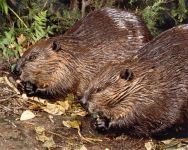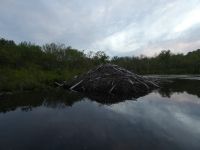Beaver Tales from Unexpected Wildlife Refuge, December 2021
Beaver lodge on main pond
The winter season at Unexpected has begun, and though we may not always see the animals at work, we know they are making their own preparations for food and shelter to sustain themselves and their families through the coldest months. In autumn, beavers begin to store food, cutting choice sticks of woodland trees and storing them in and around their lodges. They put on body fat for insulation and energy as food becomes scarce. The family lodge provides shelter from the colder temperatures. Using a mixture of branches, vegetation, debris, and a coating of pond mud, the structure maintains a stable temperature. Combining this with the body heat of the family, and sometimes a guest muskrat, the home will keep everyone warm and safe. As we patrol the Refuge, we are able to spot many of the lodges on the pond. You can find more photos of our beavers' activity in the Snapshots of life at the Refuge section.
News items section.
As the year draws to a close, and you may be considering charitable gifts , please keep Unexpected Wildlife Refuge in your thoughts. We, and the animals, are grateful for your continued support.
Contents of this month's newsletter:
News items
Jacob Safier volunteer
Ongoing help needed with trail maintenance
manager@unexpectedwildliferefuge.org to let us know how you can help.
Boundary trail near stations 18/19
Call for 2021 hunting 'season' patrol volunteers
manager@unexpectedwildliferefuge.org to let us know which days and times you can patrol and we will add you to the calendar.
Beavers in the news
Here are some recent news media articles concerning beavers. You can see our entire list, a tribute to this wonderful keystone species, on our Beavers in the News page . If you come across a news item on beavers, please send us the link so that we can consider it for inclusion.
How Britain’s beavers can help the UK’s conservation efforts , Teresa Levonian Cole
Beavers on Cabilla estate
By building dams, beavers regulate water flow, thereby reducing risk of flood and drought,” explains Chris. “They slow the flow of water and improve water quality as harmful nitrates and phosphates settle into the sediment. The wetlands they create also capture three times more carbon than drier meadows – and can create natural fire-breaks.
Could ‘Smokey Beaver’ help fight wildfires? , by Aaron Scott.
Jakob Shockey & Sarah Koenigsberg of The Beaver Coalition
When you think of preventing wildfires, you probably think of Smokey Bear. But there’s another animal that plays a much bigger role in fighting and recovering from fire: beavers.
Campaigns for animals in New Jersey
Bee on flower
Save the bees. Urge New Jersey lawmakers to approve A2070/S1016 now. Please sign and share this petition :
Urge New Jersey lawmakers to approve A2070/S1016 now
Lab testing on rabbit
Good news! Governor Murphy signed the Humane Cosmetics Act. Insider NJ article listing the signed bills here .
Snapshots of life at the Refuge
River otter family in miller pond
River otter family in miller pond
River otter family in main pond
River otter family in main pond
River otter family active day and night
Spider cricket
Spider crickets are neither spiders nor crickets
Snail on decaying log
Snail trails and travels
Autumn meadowhawk
Autumn meadowhawk dragonfly active into late fall
Red-backed salamander
Secretive salamander spotted among debris
Great blue heron in main pond
Great blue heron in main pond
Great blue heron displays powder downs
Beaver dam in main pond
Beaver lodge in main pond
Beaver lodges in main pond
An array of beaver construction around the Refuge
Take action to help wildlife at the Refuge
Otters
Continuing reminder about helping us help wildlife today We depend entirely on the support of our donors for our day-to-day expenses! As the year draws to a close, we still have not received sufficient donations to cover our nominal budget for the year . We know that you have limited resources and need to consider which of numerous worthwhile causes to support. We hope, however, that you can again find it possible to give us a donation – today – of any amount. We and the wildlife need your support now .
Wolf
Simple ways to help the Refuge
Contact us
Unexpected Wildlife Refuge
http://unexpectedwildliferefuge.org/
info@unexpectedwildliferefuge.org







